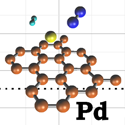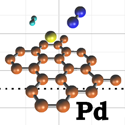Keep Oxygen Out
Hydrogen is a promising source of renewable energy for transportation, but a key challenge is to find a lightweight material to store and extract hydrogen efficiently. Carbon-based compounds such as nanotubes and graphene decorated with metallic atoms have been proposed as storage candidates. First-principles calculations show that these materials, which have a large surface area, favor hydrogen adsorption. However, experiments have not yet found a suitable material that delivers on all the criteria required for applications.
Writing in Physical Review Letters, Agustin Sigal and colleagues from the National University of Córdoba, Argentina, have used density functional theory to calculate the adsorption energy of hydrogen and oxygen on graphene decorated with a variety of metals. Sigal et al. find that oxygen interferes with hydrogen adsorption by blocking the sites where it could take place and by irreversibly oxidizing the metallic sites. Energetically, they find that the most favorable metallic decorations on graphene are those made of nickel, palladium, and platinum. Even in the most promising cases, it is found that oxygen partial pressure must be reduced to an ultrahigh-vacuum level in order to allow efficient hydrogen storage. These findings identify oxygen interference as a major obstacle to storing hydrogen on a carbon scaffold. – Sarma Kancharla





